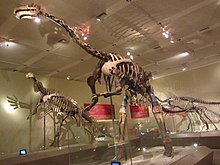| Suzhousaurus Temporal range: Early Cretaceous,
~ | |
|---|---|

| |
| Mounted skeleton displayed in National Museum of Natural Science with elements from both specimens | |
| Scientific classification | |
| Domain: | Eukaryota |
| Kingdom: | Animalia |
| Phylum: | Chordata |
| Clade: | Dinosauria |
| Clade: | Saurischia |
| Clade: | Theropoda |
| Clade: | †Therizinosauria |
| Superfamily: | †Therizinosauroidea |
| Genus: | †Suzhousaurus Li et al. 2007 |
| Type species | |
| †Suzhousaurus megatherioides Li et al. 2007
| |
Suzhousaurus (meaning "Suzhou lizard") is a genus of large therizinosauroid dinosaur from the Early Cretaceous of China. The genus is known from two specimens discovered on the Xiagou Formation and Zhonggou Formation—which are situated in the Xinminbao Group. These findings were made during field-works in 1999 and 2004. Though Suzhousaurus is known from these two specimens, an earlier named and described therizinosauroid from the adjacent basin, "Nanshiungosaurus" bohlini, may be synonymous with the former. However, Suzhousaurus can not be compared to this species due to non-overlapping material and the loss of the same. Moreover, this synonymy will result in Suzhousaurus bohlini with "N". bohlini having priority.
Suzhousaurus was an unusually large Early Cretaceous therizinosauroid reaching lengths of 6 m (20 ft) and nearly 3.1 t (3,100 kg) in weight. The upper arm (humerus) was very distinct from therizinosaurids, making Suzhousaurus to be considered as a therizinosauroid. Unlike derived (advanced) therizinosaurids, the vertebral column was not highly pneumatized, however, the pelvis shows a marked therizinosaurid-like opisthopubic build. Like other therizinosauroids, Suzhousaurus had elongated claws and neck for browsing, robust hindlimbs and a large trunk that ended on a reduced tail.
With the description of the more complete second specimen, the autapomorphies and validity of Suzhousaurus became more clear and with this, numerous anatomical traits indicate that Suzhousaurus is a non-therizinosaurid therizinosauroid, therefore, excluded from the derived Therizinosauridae, though the genus is often recovered as the sister taxon of this family.